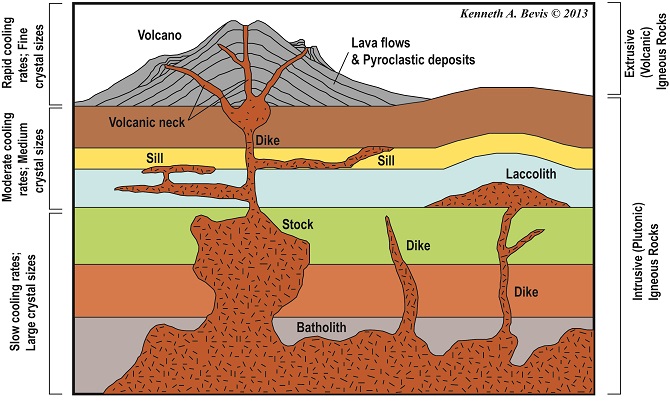Plutonic Rocks
Intrusive igneous rocks are formed from magma that cools and solidifies within the crust, surrounded by pre-existing rock (called country rock), the magma cools slowly, and as a result these rocks are coarse grained. The mineral grains in such rocks can generally be identified with the naked eye.Igneous rocks can be classified according to chemical or mineralogical parameters:
• felsic igneous rocks containing a high silica content, greater than 63% SiO2
• intermediate igneous rocks containing between 52 – 63% SiO2
• mafic igneous rocks have low silica 45 – 52% and typically high iron – magnesium content
• ultramafic rock igneous rocks with less than 45% silica. (examples picrite, komatiite and peridotite)
• alkalic igneous rocks with 5 – 15% alkali (K2O + Na2O) content or with a molar ratio of alkali to silica greater than 1:6.
Chemical classification also extends to differentiating rocks which are chemically similar:
• Ultrapotassic; rocks containing molar K2O/Na2O >3
• Peralkaline; rocks containing molar (K2O + Na2O)/ Al2O3 >1
• Peraluminous; rocks containing molar (K2O + Na2O)/ Al2O3 <1
Intrusive rocks can also be classified according to the shape and size of the intrusive body and its relation to the other formations into which it intrudes. Typical intrusive formations are batholiths, stocks, laccoliths, sills and dikes.
• Batholiths: are large mass of intrusive igneous that forms from cooled magma deep in the Earth's crust. Batholiths are almost always made mostly of felsic or intermediate rock types, such as granite, quartz monzonite, or diorite.
• Stock: is a discordant igneous intrusion having a surface exposure of less than 100 km2, differing from batholiths only in being smaller. The term stock usually refers to individual, relatively small plutons (<20 km diameter). Most stocks are probably the cupolas of hidden batholith.
• Lopoliths: a large igneous intrusion which is lenticular in shape with a depressed central region. Lopoliths are generally concordant with the intruded strata, with dike or funnel-shaped feeder bodies below the body. The term was first defined and used by Frank Fitch Grout during the early 1900s in describing the Duluth gabbro complex in northern Minnesota and adjacent Ontario. Lopoliths are huge in size; the Bushveld intrusive complex in South Africa, for example, has an area of about 66,000 square kilometres and an exposed thickness of 8 kilometres.
• Laccolith: is a sheet intrusion (or concordant pluton) that has been injected between two layers of sedimentary rock. The pressure of the magma is high enough that the overlying strata are forced upward, giving the laccolith a dome or mushroom-like form with a generally planar base.
• Phacolith: are pluton parallel to the bedding plane (or foliation) of folded country rock. More specifically, it is a typically lens-shaped pluton that occupies either the crest of an anticline or the trough of a syncline. The term was coined and initially defined by Alfred Harker in his The Natural History of Igneous Rocks in 1909.
• sills: is a tabular sheet intrusion that has intruded between older layers of sedimentary rock, beds of volcanic lava or tuff, or along the direction of foliation in metamorphic rock. A sill is a concordant intrusive sheet, meaning that a sill does not cut across preexisting rock beds.
• Dikes: are discordant tabular plutons; they form from magma that is forced into cracks rather than between beds of sedimentary rock.

Shape and size of the intrusive body
A plutonic rock may be classified mineralogically based on the actual proportion of the various minerals of which it is composed (called the mode). In any classification scheme, boundaries between classes are set arbitrarily. The International Union of Geological Sciences (IUGS) Subcommission on the Systematics of Igneous Rocks in 1973 suggested the use of the modal composition for all plutonic igneous rocks with a color index less than 90. A second scheme was proposed for those plutonic ultramafic rocks with a color index greater than 90.

QAPF Diagram for plutonic rocks.

Castle Peak is the highest point on the Idaho Batholith, USA.

Enchanted Rock laccolith, Texas (USA).

Tomichi Dome laccolith, Colorado (USA).

A stock of syenite, southern Israel.

Basaltic sill. Yellowstone National Park, Wyoming (USA).

Basaltic dykes.

schematic representation of tow pacoliths.

